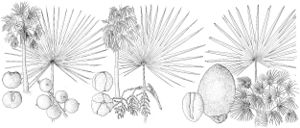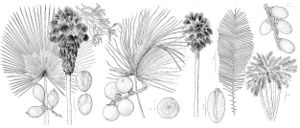Arecaceae
Trees or shrubs [lianas], perennial, branched or unbranched, solitary or clustered. Roots adventitious, thick. Stems woody, subterranean or terrestrial, creeping or erect [climbing], slender or massive, sometimes conspicuously enlarged and storing starch and water, smooth or covered with fibrous or prickly remains of leaf bases. Leaves spirally arranged; sheaths tubular, often forming crownshaft, sometimes with ligular appendages; petioles terete, channeled, or ridged, unarmed or bearing prickles or marginal teeth; hastula (flap of tissue from petiole apex at junction with surface of blade) absent or present adaxially, rarely present abaxially. Leaf blade palmate, costapalmate (intermediate between palmate and pinnate), pinnate, or 2-pinnate [undivided]; plication (folding lengthwise into pleats or furrows) ^ - or tent-shaped (reduplicate, splitting along abaxial ridges) or V-shaped (induplicate, splitting along adaxial ridges); segments lanceolate, linear, or cuneate [rhombic], glabrous or variously scaly, unarmed or bearing prickles (proximal segments modified into spines in Phoenix). Inflorescences from solitary [clustered] axillary buds, borne within, below, or above crown of leaves, paniculate, rarely spicate, usually branched to 1–5 orders; prophyll (1st bract on main inflorescence axis) 2-keeled; peduncular bract(s) (empty bract[s] between 1st prophyll and 1st bract subtending branch) present [absent]; flowers bisexual, unisexual with staminate and pistillate on same plants or on different plants, or both bisexual and unisexual on same plant. Flowers solitary or variously clustered along rachillae of inflorescence, radially symmetric; perianth 1–2-seriate; sepals [2–]3[–4], distinct or connate; petals [2–]3[–4], distinct or variously connate; androecium: stamens [3–]6–34[–1000]; filaments distinct or connate or basally adnate to petals; anthers basifixed or dorsifixed, dehiscing latrorsely or introrsely; staminodes in pistillate flowers distinct or variously connate or adnate to pistil or petals; pistils 1 or 3, distinct or partially connate, each bearing 1 ovule and 1 stigma, or 1 pistil bearing 1–3 ovules and 3 stigmas; styles distinct or connate, short; stigmas dry; pistillode in staminate flower present or absent. Fruits drupaceous or berrylike; stigmatic remains basal or apical; exocarp smooth, warty, prickly, or hirsute [corky or scaly]; mesocarp fleshy or dry and fibrous; endocarp papery, leathery, or bony, sometimes with 3 germination pores. Seeds 1(–2+), free or adhering to endocarp; seed coat thin; endosperm homogeneous or ruminate, sometimes penetrated by seed coat; embryo basal, lateral, or apical, peglike, minute; eophyll (1st seedling leaf with blade) undivided and lanceolate or 2-cleft [pinnate].
Distribution
Worldwide, especially abundant in Central America, South America, se Asia.
Discussion
Although palms appeared in various taxonomic schemes since the time of Linnaeus, the first attempt at a modern phylogenetic classification of the palms was published by H. E. Moore Jr. (1973). Moore left his "major groups" unranked, and his untimely death in 1980 prevented his completing a formal synthesis. J. Dransfield and N. W. Uhl (1986) gave formal ranks to Moore’s groups and divided the family into six subfamilies and numerous tribes and subtribes. Their Genera Palmarum (N. W. Uhl and J. Dransfield 1987, 1999) is a model of accuracy and completeness and will long serve the needs of the scientific, horticultural, and resource-management communities. With the advent of molecular techniques and a resurgence in palm research, however, realignments in the classification may be expected, and indeed additional data already require some changes in the current scheme (A. Barford 1991; R. G. Bernal et al. 1991; J. L. Dowe and N. W. Uhl 1989; J. Dransfield 1989, 1991; J. Dransfield and H. J. Beentje 1995, 1995b; A. Henderson and M. J. Balick 1991; N. W. Uhl and J. Dransfield 1999; N. W. Uhl et al. 1990, 1995.)
Modern cladistic analyses place the palms as the sister group to the Commelinanae clade (M. W. Chase et al. 1993; J. I. Davis 1995; M. R. Duvall et al. 1993b), with which they share ultraviolet-fluorescent phenolic compounds in their cell walls and Strelitzia-type epicuticular wax morphology (W. Barthlott and D. Frölich 1983; P. J. Harris and R. D. Hartley 1980). Palms are currently treated as the sole representative of the superorder Arecanae, order Arecales (R. M. T. Dahlgren et al. 1985; R. F. Thorne 1992b).
Morphologically the family is diverse and complex (see especially P. B. Tomlinson 1990). The majority of palms produce a single indeterminate stem with axillary inflorescences; several noteworthy departures, however, also occur in numbers of vegetative and floral axes, position of inflorescence, and displacement of terminal bud. Stems may be solitary (monopodial) or clustered (sympodial), erect, prostrate, or lianoid. A majority of palms have unbranched vegetative axes, although aerial branching, sometimes dichotomous, is known in a variety of unrelated genera (e.g., Korthalsia Blume, Nannorrhops H. Wendland). Branching may also be nonaxiallary in some genera (J. B. Fisher et al. 1989).
Studies of pollination (F. Borchsenius 1997; F. Ervik and J. P. Feil 1997; A. Henderson 1986; C. Listabarth 1992, 1993, 1993b, 1994; A. O. Scariot et al. 1991) indicate that insect pollination, especially by beetles (Coleoptera), bees and wasps (Hymenoptera), and flies (Diptera), is apparently more common than wind pollination. Bats (Chiroptera) play a role in the pollination of some species (S. A. Cunningham 1995).
Dispersal of seeds is generally by means of animals for fleshy-fruited palms (S. Zona and A. Henderson 1989). Many species of mammals include palm fruits in their diets (S. H. Bullock 1980; R. F. Harlow 1961; W. D. Klimstra and A. L. Dooley 1990; D. S. Maehr 1984; D. S. Maehr and J. R. Brady 1984), but birds also play a significant role. In the Eastern Hemisphere, Cocos Linnaeus and Nypa Steck have achieved a wide distribution as the result of dispersal by water. For the relationship between palms and seed-eating bruchid beetles (Bruchidae: Pachymerinae: Pachmerini), see C. D. Johnson et al. (1995).
Genera 1914, species ca. 2500 (19 genera, 29 species in the flora).
Selected References
Lower Taxa
Illustrations
Key
| 1 | Leaf blades palmate to costapalmate. | > 2 |
| 1 | Leaf blade pinnate or 2-pinnate. | > 9 |
| 2 | Gynoecium of 3 distinct pistils, tomentose; leaf sheath armed with coarse needlelike fibers | Rhapidophyllum |
| 2 | Gynoecium of 3 pistils partially connate, or apparently unicarpellate, glabrous; leaf sheath producing soft fibers. | > 3 |
| 3 | Perianth 1-seriate. | > 4 |
| 3 | Perianth 2-seriate. | > 5 |
| 4 | Petiole split at base; exocarp white; seed excavate or perforate, not furrowed | Thrinax |
| 4 | Petiole not split at base; exocarp purplish; seed irregularly brain-shaped | Coccothrinax |
| 5 | Petioles entirely unarmed; rachillae of inflorescence glabrous | Sabal |
| 5 | Petioles, especially basal portions, coarsely to obscurely armed, rachillae of inflorescence pubescent or glabrous. | > 6 |
| 6 | Stems procumbent or ascending; hastula present on both surfaces of leaf | Serenoa |
| 6 | Stems erect; hastula present on adaxial surface of leaf. | > 7 |
| 7 | Stems less than 15 cm diam., clustered | Acoelorraphe |
| 7 | Stem more than 20 cm. diam., solitary. | > 8 |
| 8 | Petiole split at base; leaf segments bearing fibers | Washingtonia |
| 8 | Petiole not split at base; leaf segments not bearing fibers. | Livistona |
| 9 | Leaf segment plication induplicate (V-shaped). | > 10 |
| 9 | Leaf segment plication reduplicate (Λ-shaped). | > 11 |
| 10 | Leaves pinnate; leaf segment apices acute; basal segments modified into spines | Phoenix |
| 10 | Leaves 2-pinnate (in mature plants); leaf segment apices jagged and irregular; basal segments not modified into spines | Caryota |
| 11 | Plant (especially leaves) armed. | > 12 |
| 11 | Plant with unarmed trunks, leaf bases, and leaf rachises. | > 13 |
| 12 | Petiole margins unarmed, trunk and blades armed | Acrocomia |
| 12 | Petiole margins armed (base of midvein lignified and persisting as spine), trunk and blades unarmed | Elaeis |
| 13 | Flowers mostly bisexual (distal flowers with reduced gynoecia), borne singly on rachillae on pedicel-like stalks | Pseudophoenix |
| 13 | Flowers unisexual, sessile. | > 14 |
| 14 | Staminate and pistillate flowers on different plants; stems clustering | Chamaedorea |
| 14 | Staminate and pistillate flowers on same plants; stems various. | > 15 |
| 15 | Crownshaft absent. | > 16 |
| 15 | Crownshaft present. | > 17 |
| 16 | Fruits dry, greater than 10 cm diam | Cocos |
| 16 | Fruits fleshy, less than 4 cm diam. | Syagrus |
| 17 | Stems solitary, greater than 20 cm diam | Roystonea |
| 17 | Stems solitary or clustered, less than 15 cm diam. | > 18 |
| 18 | Leaf segment apices jagged and irregular; leaf sheath green; endocarp 5-lobed in cross section | Ptychosperma |
| 18 | Leaf segment apices acuminate; leaf sheath yellowish; endocarp terete in cross section | Dypsis |


